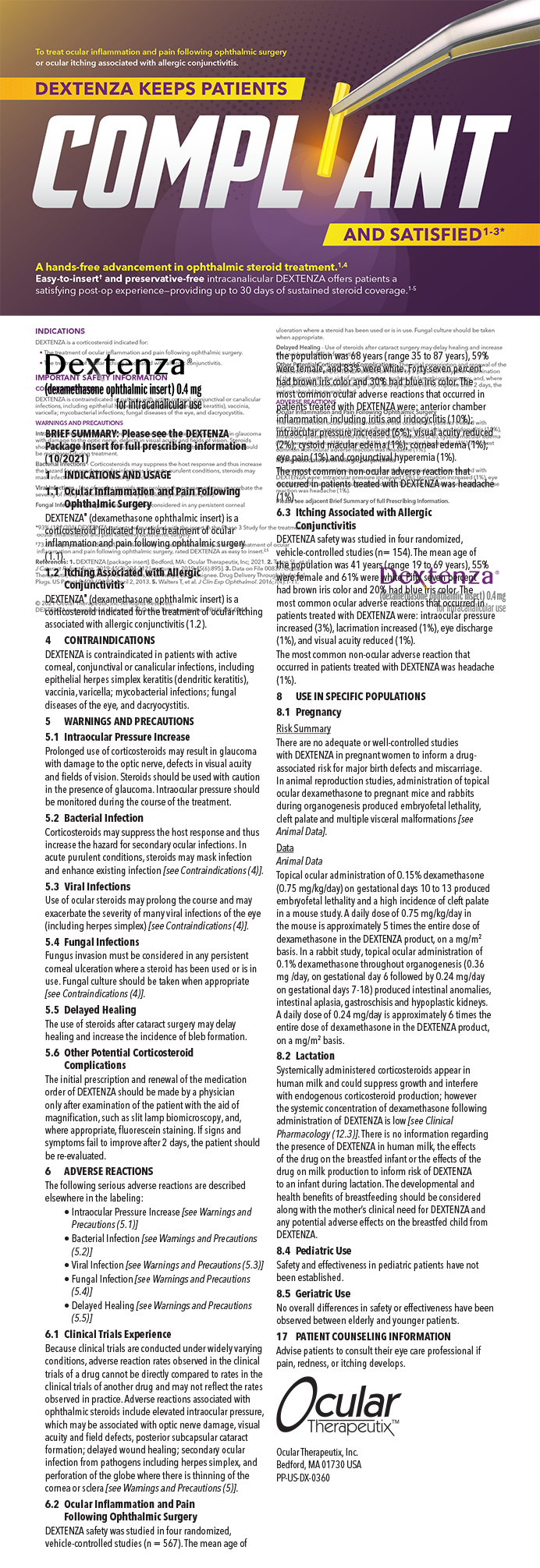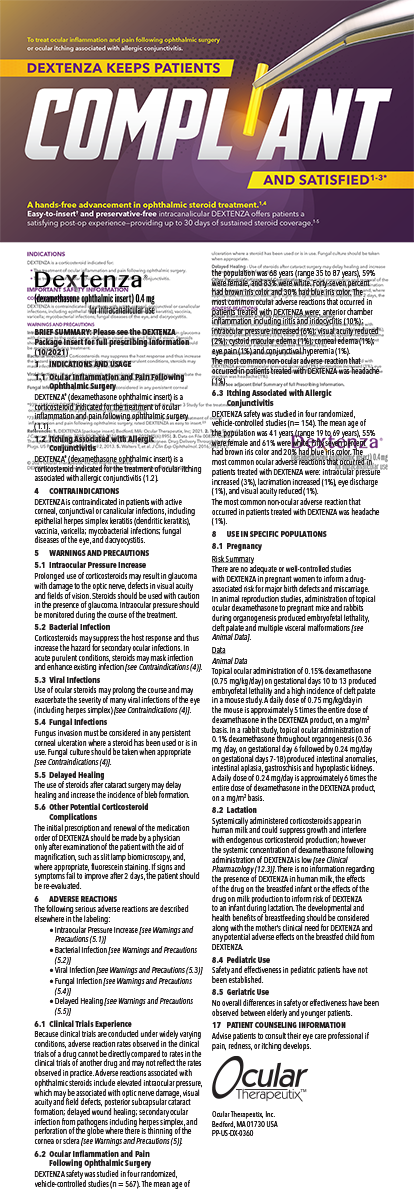Topical and/or intracameral antibiotics play a key role in any strategy designed to maximize endophthalmitis prophylaxis. The optimal strategy for reducing the incidence of endophthalmitis always includes the two classic goals of (1) decreasing the bacterial exposure on the lids and lashes prior to surgery and (2) maximizing aqueous penetration to assist the body’s natural defenses when bacterial agents enter the eye intraoperatively or postoperatively. Errors in prescribing periocular antibiotics can foil the achievement of these essential goals of endophthalmitis prophylaxis. The following, in my opinion, are errors regarding the prophylaxis of endophthalmitis.
ERROR NO. 1
The first mistake is stopping postoperative topical antibiotics too soon. Because the traditional teaching was that patients with endophthalmitis usually present postoperatively between days 2 and 5, until recently, most surgeons prescribed a fourth-generation fluoroquinolone q.i.d. for 1 week after surgery. Recently, Moshirfar and colleagues published evidence suggesting that a significant percentage of patients with endophthalmitis present after the first postoperative week— when antibiotics have been discontinued.1 The mean time to the presentation of endophthalmitis in Moshirfar’s study was 9.3 days, which strongly suggests that surgeons should continue postoperative topical therapy for at least 2 weeks.
ERROR NO. 2
In an effort to decrease the bacterial load on the lids preoperatively, many surgeons prescribe lid hygiene for 2 or 3 days prior to cataract surgery. My colleagues and I performed a study in which we compared the impact on preoperative conjunctival cultures of (1) treatment with fluoroquinolones alone (with benzalkonium chloride), (2) lid hygiene alone, (3) the combination of lid hygiene and fluoroquinolone therapy, and (4) control (no preoperative treatment).2 Conjunctival cultures were obtained before the application of povidoneiodine. The fluoroquinolone-alone group had a 30% reduction in colony-forming units compared with the control group. The lid hygiene-alone group actually had a 20% increase in colony-forming units, whereas the combined group experienced a reduction in colonyforming units of 80% compared with the control group. Error No. 2 is therefore failing to combine a “days preoperatively” topical fluoroquinolone with lid hygiene before cataract surgery.
A number of researchers have clearly shown that, although moxifloxacin demonstrates excellent aqueous penetration, it does not provide adequate surface kill within 1 to 2 hours after application compared with gatifloxacin (with benzalkonium chloride).3-6 A strategy of immediate preoperative pulsing without “days preoperatively” moxifloxacin would make surgeons vulnerable to committing error No. 2.
ERROR NO. 3
During the past decade, a significant percentage of US cataract surgeons used vancomycin in the infusion bottle, but I do not believe the scientific evidence supports this practice. This strategy has been associated with cystoid macular edema,7 and the potential for errors in dilution has always been an issue of great concern. The concentration and total amount of the drug delivered cannot be verified, because the amount of fluid passing through the eye varies in each case. If the surgeon has a strong preference for “intracameral antibiotics,” a verifiable amount of drug should be delivered as a bolus at the end of the case.
Vancomycin is frequently the last line of defense against methicillinresistant Staphylococcus aureus and methicillin-resistant Staphylococcus epidermidis for systemic therapy. Vancomycin’s routine use in the infusion bottle at the time of cataract surgery may contribute to the development of resistant organisms. The Centers for Disease Control and Prevention have specifically recommended that vancomycin not be used as a routine prophylactic therapy during cataract surgery.8 Thus, error No. 3 is the routine use of vancomycin in the infusion bottle at the time of cataract surgery.
ERROR NO. 4
The pharmacokinetics and pharmacodynamics of the fluoroquinolones make them an excellent choice for use in endophthalmitis prophylaxis. They offer broad-spectrum coverage of both gram-positive and gramnegative organisms, and they are bactericidal. The fluoroquinolones are concentration dependent and have the capability of achieving more than adequate aqueous penetration in most cases. Thus, these agents are best used in high doses for a relatively short period of time and should be discontinued abruptly without tapering. Error No. 4 relates to the tapering of topical fluoroquinolones. If the fluoroquinolones are prescribed similarly to time-dependent bacteriostatic antibiotics with a low-dose tapering regimen, they will be less effective. Moreover, this practice will promote the development of resistant organisms.
CONCLUSION
Recent developments have demonstrated that both perioperative topical regimens and intracameral therapy combined with topical therapy can be extremely effective in achieving very low levels of endophthalmitis. Currently available antimicrobial agents and strategies for their appropriate application are powerful tools in the hands of an informed ophthalmic surgeon.
Frank A. Bucci Jr, MD, is the medical director of Bucci Laser Vision Institute in Wilkes-Barre, Pennsylvania. Dr. Bucci may be reached at (570) 825-5949; buccivision@aol.com.
- Moshirfar M,Feiz V,Vitale AT,et al.Endophthalmitis following use of fourth generation fluoroquinolones after uncomplicated cataract surgery:a retrospective,observational case series.Ophthalmology.2007;114(4):686-691.
- Bucci Jr FA.The effect of preop lid scrubs and levofloxacin on eyelid and conjunctival cultures prior to cataract surgery. Poster presented at: Association for Research in Vision and Ophthalmology Annual Meeting;May 2003,Fort Lauderdale,FL.
- Kowalski RP,Kowalski BR,Romanowski EG,et al.The in vitro impact of moxifloxacin and gatifloxacin concentration (0.5 vs 0.3) and the addition of benzalkonium chloride for antibacterial efficacy.Am J Ophthalmol.2006;142:730-735.
- Eser I,Hyon J,Hose S,O’Brien TP.Comparative antimicrobial efficacy of preserved and preservative-free topical fourth generation fluoroquinolones against various strains of Staphylococcus.Paper presented at:Association for Research in Vision and Ophthalmology Annual Meeting; April 29,2004;Fort Lauderdale,FL.
- Cha SH,Lee JS,Oum BS,Kim CD.Corneal epithelial cellular dysfunction from benzalkonium chloride (BAC) in vitro.Clin Experiment Ophthalmol. 2004;32:180-184.
- Kaufman SC,Rusinek C,Salahuddin A,et al.Comparison of the biocompatibility of gatifloxacin 0.3 and moxifloxacin 0.5.Cornea.2006;25(suppl 2):S31-S44.
- Axer-Siegel R,Stiebel-Kalish H,Rosenblatt I,et al. Cystoid macular edema after cataract surgery with intraocualr vancomycin.Ophthalmology. 1999:106:1660-1664.
- Centers for Disease Control and Prevention.A joint statement of the American Academy of Ophthalmology and the Centers for Disease Control and Prevention.The prophylactic use of vancomycin for intraocular surgery.Bethesda,MD;October 1999.


